how to do valencia
What better thing to do on a long holiday weekend than visit and explore a new city? Desperate to escape the chilly early December weather of Spain's interior, I settled on Valencia. I'd already had a brief, enjoyable visit to the Costa Blanca, and I'd heard good things about the bigger city to the north. Without much of an itinerary at all, I set off on a Thursday for a 4-day excursion to Valencia.
How to Do Valencia: Stay With a Great AirBnB Host
No guide book or self-researched travel itinerary beats the hands-on help of a capable and compatible host. Luckily, I found both in Guillermo, my AirBnB host in Valencia. Not only did he meet me at the train station on arrival, he was kind enough to share his lunch with me after showing me the way to his flat.

Home-cooked lunch at Guillermo's
As we chatted over lunch, I learned that Guillermo was a native of El Salvador, and was studying urban planning and development. He'd lived off and on in Valencia for 16 years, so I knew he was well qualified to give me some good advice on what to see and do around town.

Guillermo's surprised face when he's not expecting to be photographed.
Before I headed out to do some exploring on my own, Guillermo provided me a selection of maps to use during my stay, and quickly gave me the lay of the land.
Where I Stayed: AirBnB Private Room in Ruzafa, Valencia
How to Do Valencia: See the Sights in Ciutat Vella (Old Town)
After resting up a bit, I decided to head out and walk around the historic area of Valencia, otherwise known as Ciutat Vella. Despite Guillermo's map and explaining, I managed to get a little turned around during my stroll, but still found my way to the following points of interest.

Porta de la Mar - at the eastern end of Ciutat Vella

Christmas lights and shopping on Carrer del Pau

The Valencia Cathedral, or, the Metrpolitan Cathedral-Basilica of the Assumption of Our Lady of Valencia

Torres de Serranos at the northern end of Ciutat Vella, El Carmen

Torres de Serranos - front view

Christmas lights at the Plaza del Ayuntamiento in Valencia

Plaza de Toros, Valencia
Sights to See in Ciutat Vella, Valencia (Spanish)
How to Do Valencia: Wander Around the Ruzafa Market
Saturday morning on a holiday weekend. I wake up early-ish, and the only thing on my mind is, "Gawd, I hope the market is open." As I mentioned in an
, visiting the local market is one of my favorite ways to get a sense of the culture and flavor of a Spanish city. The Ruzafa market was a treat, and I spent at least an hour strolling through, peering at the fresh items on offer at each of the stalls, and trying to stay out of the way of the old folks who were out early getting their shopping done before the official start of the holiday. I was even able to try a few free samples - 1 was of some amazing roasted pumpkins (I bought a half to take home for a snack later), and the other was of a really nice cava on sale at a wine shop in the market. Guillermo joined me at the market later and showed me to a coffee shop in the market that serves coffee for free (tips accepted) - since they make their money on bulk sales of beans. A great way to start the day!




Free samples of cava? Why yes, thank you.
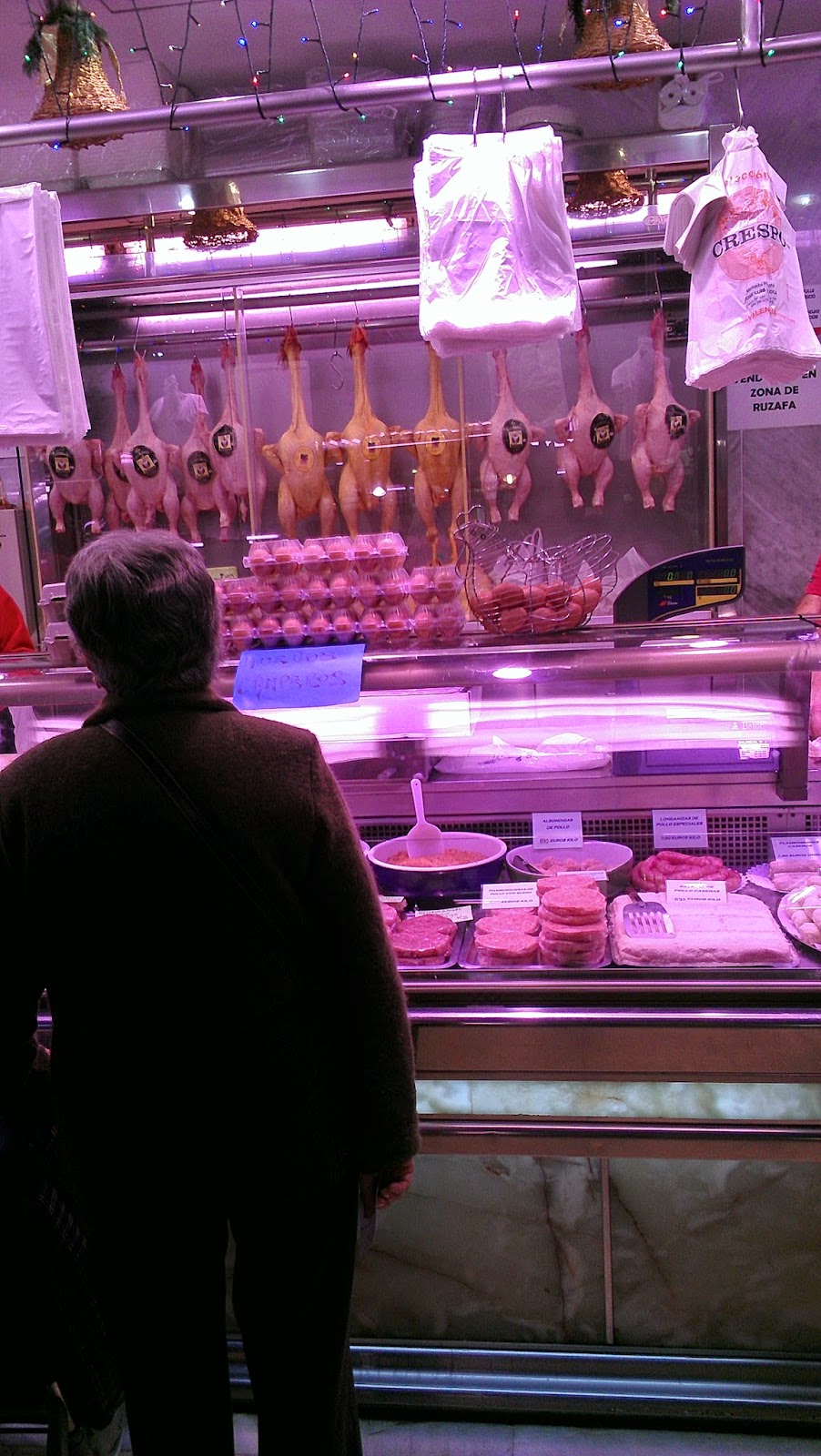

roasted pumpkins - you get to try before you buy

How to Do Valencia: Taste Authentic Argentinian Italian Pizza
I had no idea that there was a significant Italian community in Argentina, but I found out when I visited La Nonna - an Argentinian Italian restaurant in Valencia. The owners hail from Argentina, and the restaurant's menu boasts a mouth-watering selection of brick-oven Italian pizzas along with some Argentinian steak and meat dishes.
The pizzas are top notch - crispy but tender crust, fresh topping, and the gooiest of cheeses. La Nonna features a daily menu that allows you to select a salad or small plate as a first course, your choice of pizza, along with drink and a dessert for about 12euro.

Carpaccio de pulpo - La Nonna
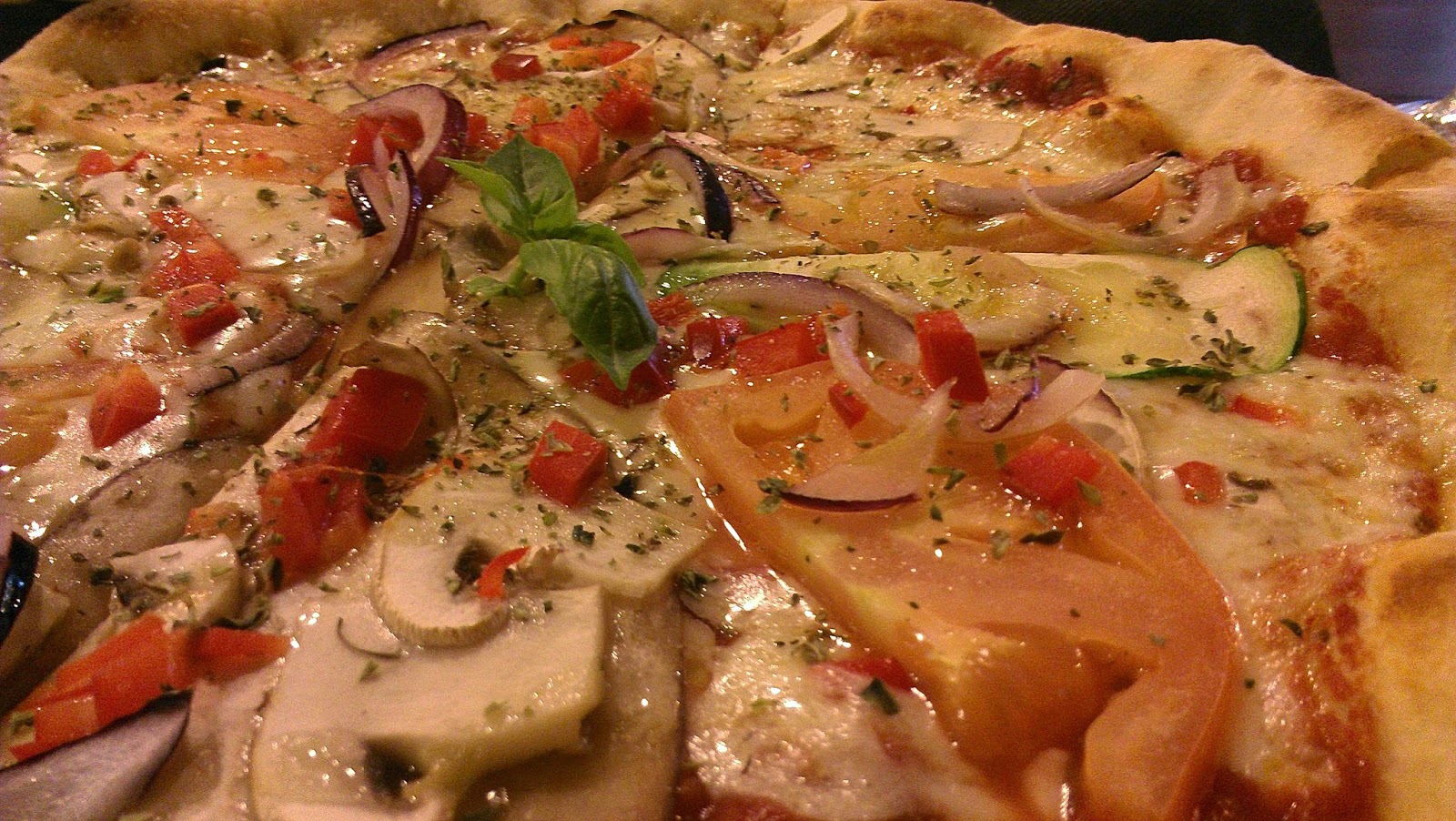
Veggie pizza at La Nonna
La Nonna Calle Puerto Rico, 16 Valencia, Spain
How to Do Valencia: Hang with the Hipster Set at Calypso
We enter the smallish bar and order a couple of beers. As my eyes adjust to the darkness, I wonder not only where I am, but
when
. The music is a non-stop selection of 60s surfer and ska tunes .The DJ, who for some unexplicable reason is wearing a Mexcan luchador mask, seems thrilled to be providing the ambience for the evening. He bobs his head and does a little funky two step to the music. I scan the rest of the room, taking in the scene. The decor is best described as retro tiki chic. Overhead, a tiny tv is showing original versions of the Super Friends cartoon. I am the only one paying it any attention, however. The rest of the steadily swelling crowd at Calypso presents varying shades of hipster as they chat and sip their drinks. Skinny jeans, wallet chains, lumberjack shirts, carefully ungroomed beards, blunt-cut bangs, cat eye glasses, red-as-red-can-be lipstick... all the expected accoutrements are there. Well, all except one. There's a total lack of irony among the patrons, instead there's an easy, genuine feeling of 'hey, we're just here to have a good time, not to pose and look cute.' As I approach the bar for my second round, the bartender holds up a vintage camera and captures me with a flash. The luchador-DJ points and nods his approval.



Calypso Russafa Carlos Cervera, 9 Valencia, Spain
How to Do Valencia: Have Sunday Paella with a Valencian Nationalist
Guillermo invites me out to have
beers with him and his friend, Vicént. “He’s very nationalist,” Guillermo warns. I’m not sure I like the sound of that. “What exactly,” I cautiously begin, “do you mean by ‘nationalist’?” “Well, he only speaks Valenciano. When a Spanish team is playing a football match, he roots for the other team. When he tells people where he’s from, he doesn’t say I’m Spanish, he says, I’m Valencian. If he could, he’d prefer that his passport said that, but since he can’t change it, he’s stuck with it saying he’s from Spain. But don’t worry, he likes to practice his English.” Well, I think. This should be… fun. As it turns out, Guillermo was exaggerating a bit. Or, maybe Vicént was on his best behavior. Throughout the night we shift as easily between English, Castellano, and Valenciano (them, not me) as we do from 1 bar to the next. At the second bar, after Vicént explains to me over the loud music that he lives in a neighborhood not far from the beach, I jokingly quip, “Oh, so you’re going to make a paella for us tomorrow?” As Guillermo had hipped me earlier, paella is typically eaten by Valencians for Sunday lunch, often just before or after a relaxing stroll along the Mediterranean. To my surprise, Vicént replies with barely a pause, “Yes! You should both come over around 3!” Wait. What? Guillermo had already offered to show me to a restaurant serving authentic paella that would be much better and cheaper than the touristy options along the beach. But, this? This was more than I could have expected. I turned to share the change in plans to Guillermo. His face instantly registered his shock. “Wow. That was fast!” he says

Vicent prepares what he says is not truly paella, but octopus rice. Guillermo supervises, beer at the ready.

Shared salad to accompany the main course

Vicent's 'octopus rice'

"This right here? Is how you do pumpkin," says Vicent.

All smiles! An after-lunch coffee at the cafe on the corner
How to Do Valencia: Take a Stroll Through El Cabanyal
After lunch, Vicént offers to show us around El Cabanyal – the neighborhood he grew up in and the same neighborhood his family lived in for several generations. “It used to feel like a little village,” he says. Originally a working class neighborhood of fisherman and port workers, it’s now plagued by urban blight. Kids play in the street right across from the older boys hanging out in front of the corner store. The older ones don’t go inside to buy anything. They stay outside all day to sell.


Vicént stops at regular intervals to point out one crumbling, dilapidated building after another. “My grandmother was born there. We used to go pick up huge chunks of ice over there. My uncle’s house was here. My first job was washing cars in that place over there.” I can feel the mix of wistfulness and pride in his voice.


Guillermo and Vicént share that the state of the neighborhood is an intentional move on the part of the local government. They want to expand a nearby avenue so that it connects with the beach further to the south – El Cabanyal is right in the path of this proposed throughway.
We leave El Cabanyal and stroll along the beach, catch a batucada group practicing their moves, watch the sun set over the waves. After our walk, Guillermo and I bid Vicént thanks and goodbye, and catch the metro back home.


How to Do Valencia: Have a Farewell Dinner for a New Friend
My first night in Valencia, while Guillermo and I were grabbing some eats in a nearby Cuban restaurant, I met Tanya. Tany
a was a native of Brooklyn, and was currently living and teaching English in Madrid. We all chatted cordially, and I invited Tanya to join Guillermo and I for bar-hopping after dinner. Tanya shared that she’d only just decided to come to Valencia for the holiday weekend last night. She was an experienced solo traveler, and could easily enjoy exploring a city on her own or with newly made friends wherever she happened to find them. Of course, we hit it off instantly. We exchanged contact info at the end of the night and hung out again for several hours the next day.
On Tanya’s last night in Valencia, we met up for a Moroccan dinner at Restaurant Zakaria. I'd read online about one of their more popular dishes, Cordero con ciruelas (Lamb with prunes), and decided to order it. Tanya ordered a couscous dish and we shared. While both dishes were delicious, the lamb dish was certainly more memorable. Sweet, smoky caramelized onions, well-spiced lamb, and tender prunes made for a warm, comforting blend of flavors - perfect for the slightly chilly evening weather. Portions and prices were quite good at Restaurant Zakaria. A must-visit if you like North African cuisine.


Cordero con ciruelas at Restaurant Zakaria

Chicken and vegetable couscous at Restaurant Zakaria
Our after-dinner plan to find a bar or club with some cool tunes was mostly a bust and ended up with Tanya and me going on a Google search-inspired wild goose chase around the city center that lasted ‘til the wee hours of the morning. But, in the end, it was all good. We had just as much fun getting lost, people watching, laughing like giddy teenagers, and even singing the hooks of old funk and soul tunes on the streets of Valencia. Sometimes it’s not so much about where you’re going, but who you’re travelling with.

Tanya and I outside of Havana, the Cuban restaurant where we met in Valencia
Carrer de Puerto Rico, 26, Valencia, Spain
How to Do Valencia: Head Down the River to the City of Arts & Sciences
On my last day in Valencia, I head out to explore the ‘river’, which is what the locals call the continuous band of recreational green space that snakes through most of the city. Many decades ago, it was an actual river, but after repeated floods, it was drained and turned into a park. The weather is as perfect as it can be, and there are tons of people enjoying the day – running, strolling, biking, or just soaking up the sun.



At the south end of the river, I encounter the City of Arts and Sciences, a complex of museum buildings, each one dedicated to a specific area of scientific discovery and exploration. For the sake of time, I opt not to go inside of the museums. The buildings themselves are breathtaking works of art. The combination of futuristic architecture, glittering water features, and the shifting light of the sun makes for a unique visual feast. I take far too many pictures as I walk.







How to Do Valencia: Watch a Revolutionary Screening at Recordshop
When I return to Guillermo's, he asks if I’d be up for seeing a free documentary screening at a nearby bar this evening. “Sure. Which documentary?” I query. He shows me the flyer on his computer. I nearly squeal with excitement. Turns out it’s Wattstax. I’ve been wanting to see it for years, but have never gotten around to it. I’m thrilled to have the opportunity now. We head out a little while later to Recordshop, which is part bar, part ‘cultural association’ with lots of vinyl on display. The owner regularly screens films in the space that is about as big as a large living room. Before the movie, the owner plays Jimi Hendrix’s ‘Axis: Bold as Love’ album (on an actual record player), while Guillermo and I sip beers. Soon, the movie begins. I settle into a worn couch and immerse myself in the sounds of a soulful revolution.


Recordshop Cultural Association Calle Sevilla, 31 Valencia, Spain
How to Do Valencia: Savor Handcrafted Burgers at Slaughterhouse
For my last meal in Valencia, Guillermo and I head to Slaughterhouse, a popular burger restaurant that actually was a slaughterhouse in a previous incarnation. We’d walked past the place on my first night in town, and the smell wafting out onto the street had instantly grabbed my stomach by the nose. Online reviews and Guillermo's own personal recommendation confirmed that this place made some really tasty burgers, so I was glad to have a chance to sample one before heading home. Each of the burgers on the menu at Slaughterhouse gets its name from a fillm or book that is also listed as a recommendation on the menu. All the ingredients on the burgers are fresh and/or homemade, all the way down to the ketchup.I don't always eat burgers back in the States, but when I do, I want it to be a damned good burger. Here in Spain, I've tried burgers a few times, but they've always been 'off' somehow, falling short of my expectations for a well-prepared, proper tasting burger. Thankfully, I found redemption at Slaughterhouse. The Movska burger that I ordered was everything I'd been missing from home. By this time, I wasn't even surprised. After all, in just a few days in Valencia, I had already found so much that made feel right at home.

Slaughterhouse menu

The Movska burger at Slaughterhouse

A disco ball and a meathook - part of the eclectic decor at Slaughterhouse
SlaughterhouseCarrer de Dénia, 22Valencia, Spain
How I Got There: AVE High Speed Train (Spain Pass)
I'm a heavy user of Spain's discount railway pass for non-Spanish travelers. It's called Spain Pass, and I've used it several times to visit cities that are far enough away for me to want to avoid a bus ride (my bus limit is about 3 hours). The trip to Valencia from Ciudad Real took a little over 2 hours on the high-speed train. The same trip would by bus would take about 6 hours, and cost about the same.

Have you had a chance to visit Valencia yet? Share your favorite finds in the comments!
7 things you must see in every spanish city
1. Its cathedral
 |
| The Cathedral in Toledo |
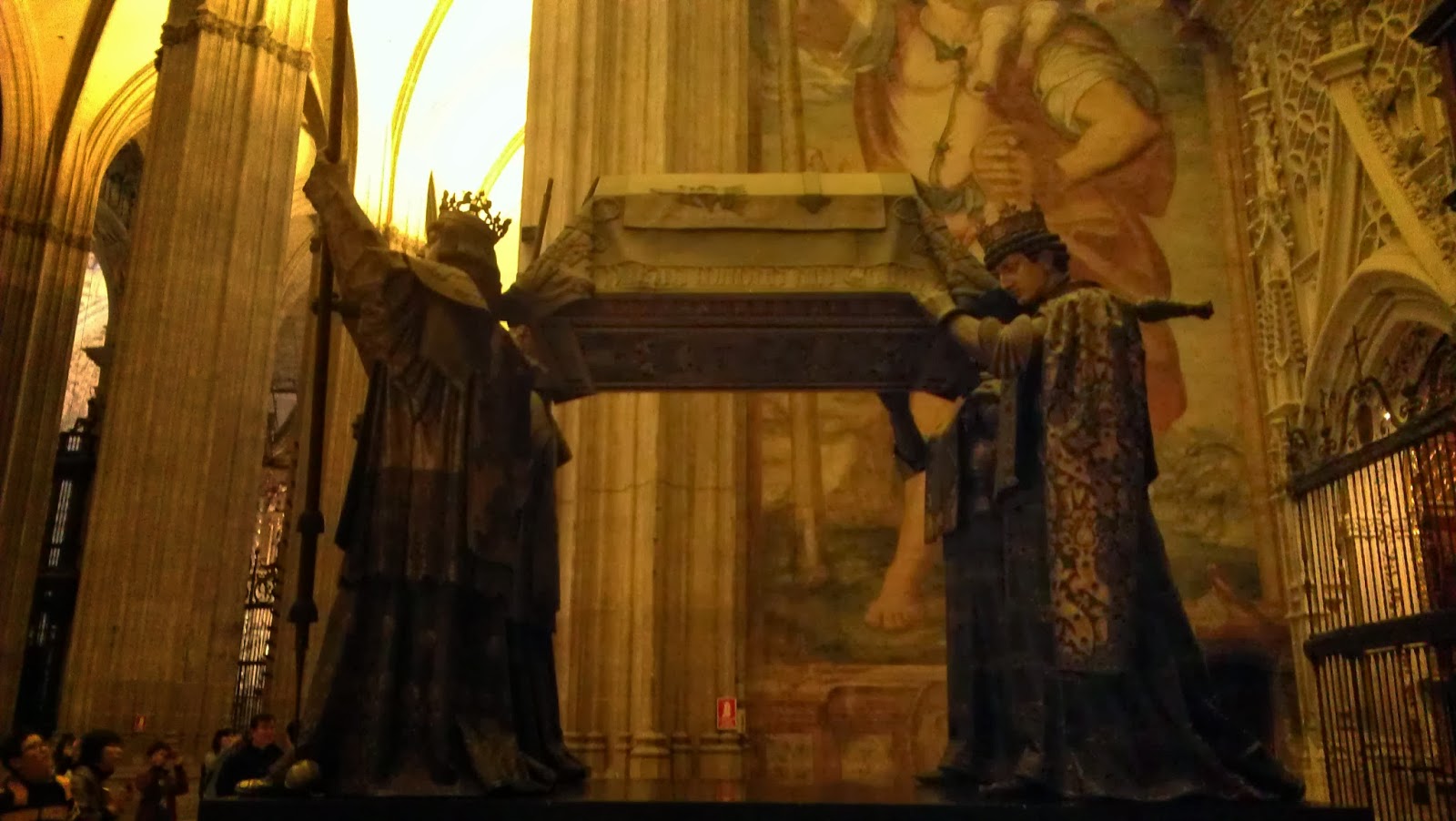 |
| Christopher Columbus' remains - inside Sevilla Cathedral |
| In Cordoba - the Cathedral is located inside of a mosque |
2. If it’s on a coast, its beach. If not, its Plaza Mayor
 |
| Waiting on fresh catch at a chiringuito at Malagueta beach |
 |
| Plaza Mayor in Ciudad Real at Christmas |
 |
| Picture-perfect view of Marbella's beach and Paseo Maritimo in winter |
3. Its most popular tapas bar or cervecería
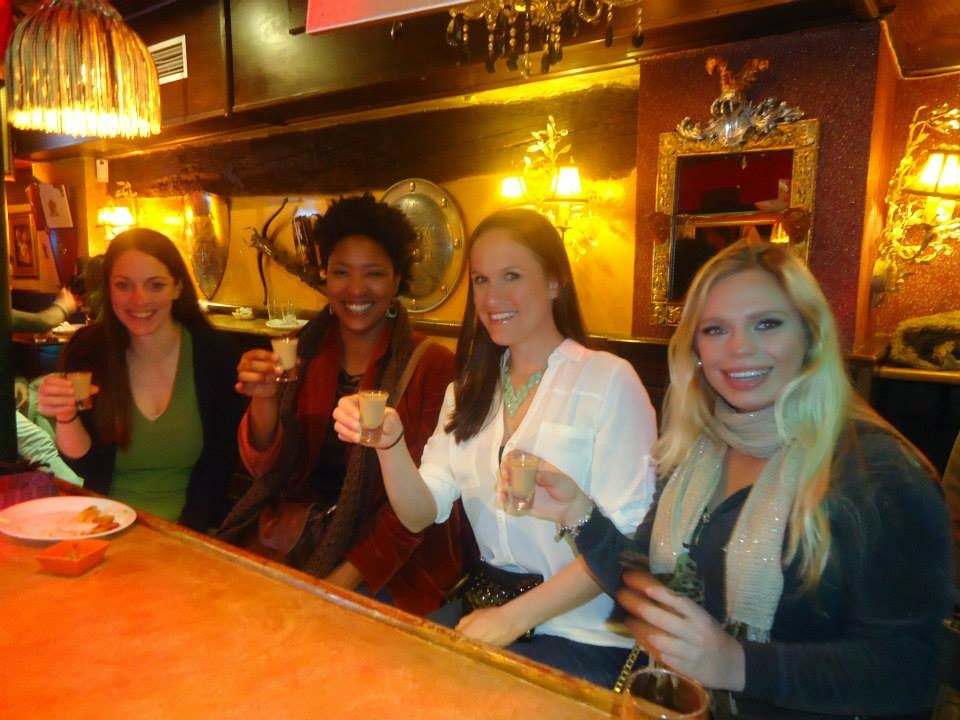 |
| Complimentary chupitos in Granada |
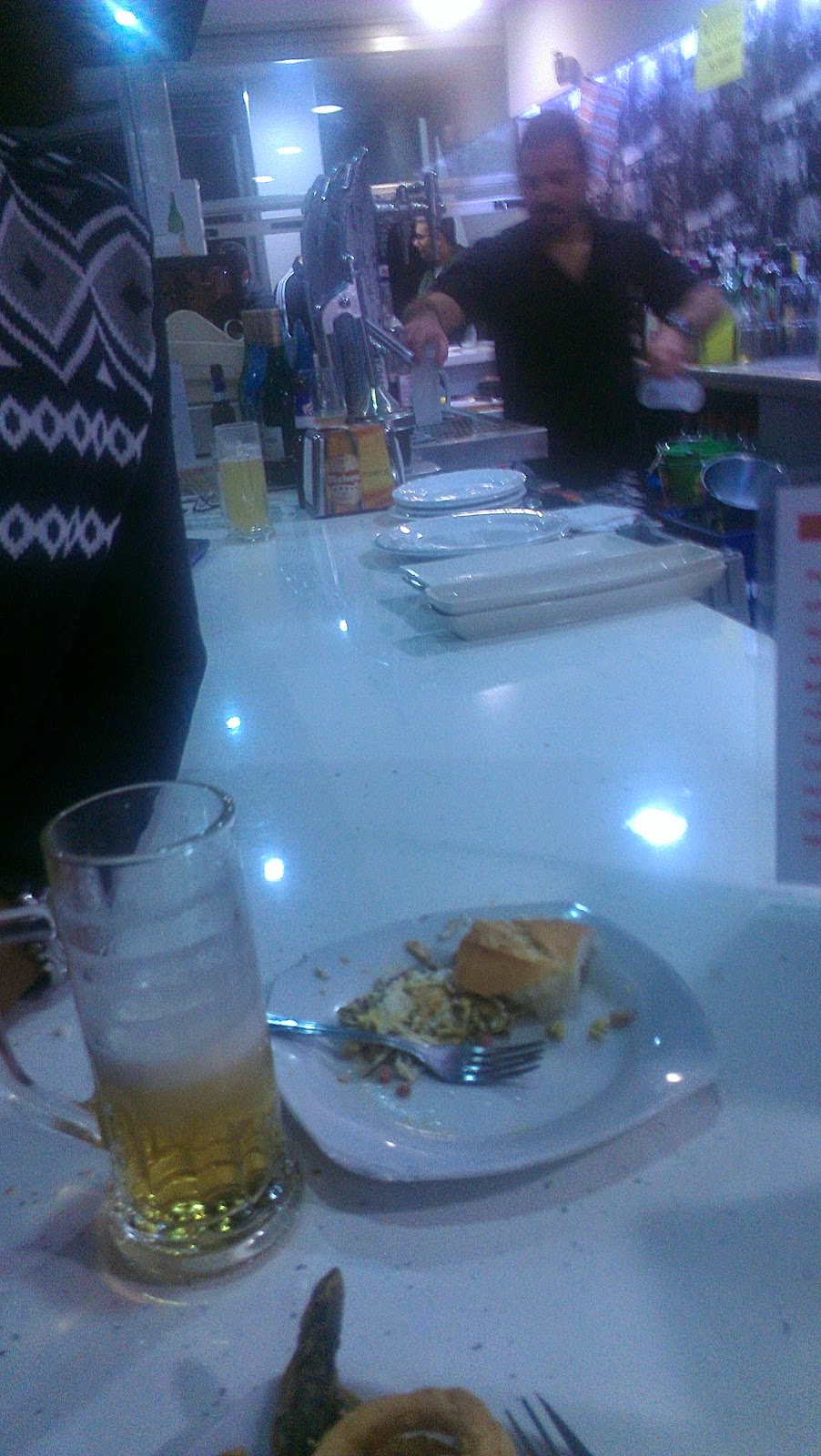 |
| Ciudad Real's El Alcazar - always crowded, always good. |
 |
| At Malaga's Antigua Casa de Guardia, the waiters chalk up your tab on the bar. |
4. Its ethnic neighborhood
 |
| At Baobab, a Senegalese restaurant in the Lavapies neighborhood of Madrid |
 |
| In Valencia's vibrant Ruzafa 'hood, new restaurants seem to pop up every day. |
 |
| At A Tu Bola, in Barcelona's Raval district, fusion albondigas are on the menu. |
5. Its municipal market
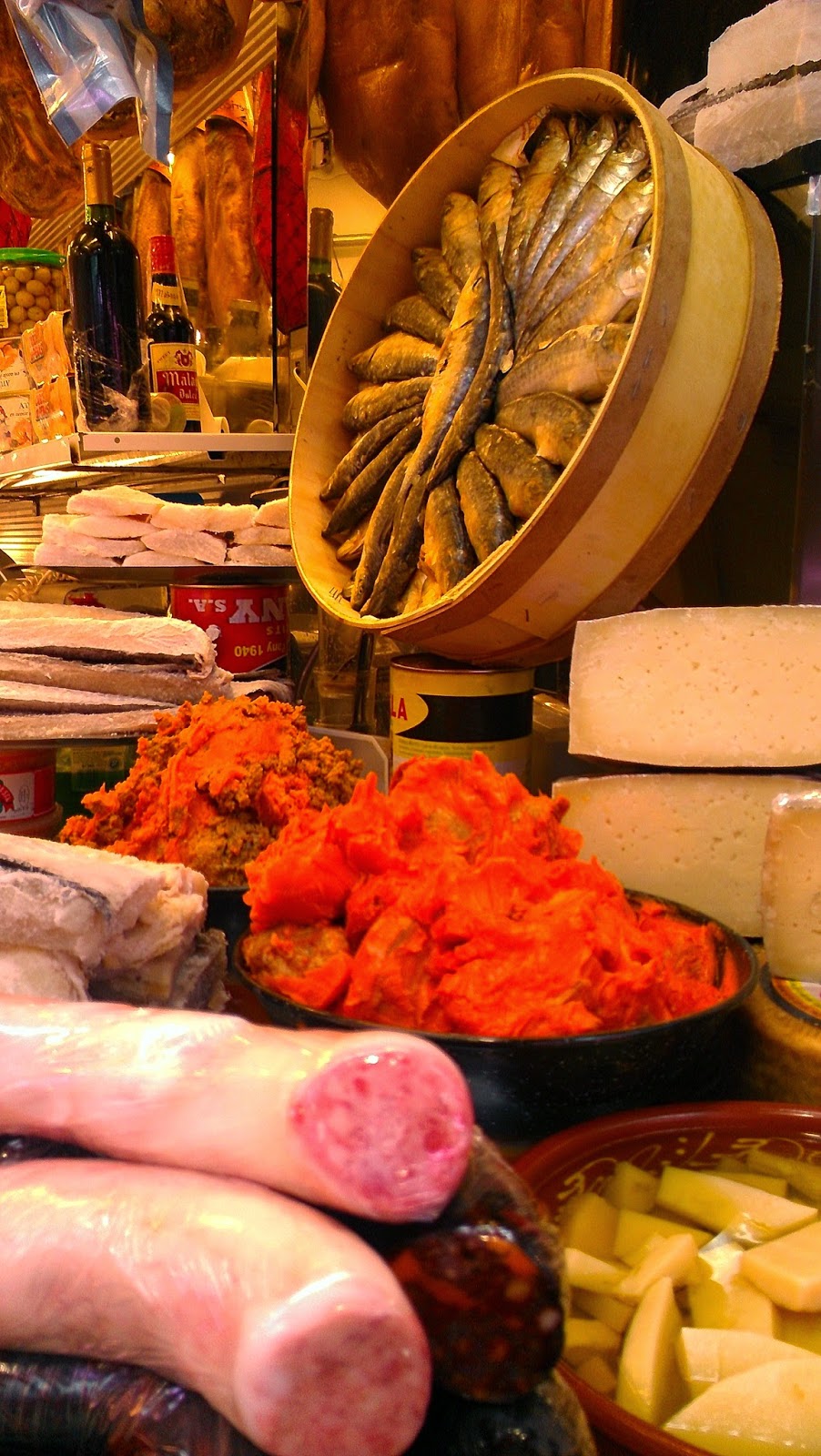 |
| Atarazanas Market, Malaga |
 |
| The central market in Cadiz is a bustling bar scene at night. |
6. Its Casco Antiguo
 |
| The most breathtaking views in Ronda are found in its old town |
 |
| Even in modern Marbella, there's a charming casco antiguo to get lost in. |
7. Its lesser known park
 |
| Ciudad Real's Parque del Pilar |
 |
| Jardin el Capricho - Madrid's other park |
highlights (and lowlights) of granada
For my first weekend excursion from Marbella, I chose to head to Granada. It's less than 3 hours away by bus, and there were a couple of other girls from my CIEE orientation heading there for the weekend as well, so I figured it was a good time to check out what the city had to offer.
When I arrived, I had the good fortune of bumping into my friends as soon as I got on the bus to head to my room for the weekend. We made plans to meet up for tapas and drinks later that night, and they headed off to their hostel nearby, while I went to go check in with my AirBnB host.
Lodging / Accomodations
Highlights: My room was right in the center of Granada, located almost directly behind the Cathedral, and with easy access to all the city buses. Lots of shops, restaurants, and bars were right out the front door, and since it was in the historic area, the architecture of both the room and the surrounding buildings was a beautiful sight to see while moving about. My host also had maps, and information on popular sights and attractions in Granada already in my room. And the nicest touch of all? She had a hot water bottle available for my use - a lucky stroke since I'd decided to leave mine at home. Did I mention how cold most Spanish homes are in the winter months?
Lowlights: All that historic architectural charm - close-together buildings, narrow cobblestone streets, high ceilings - also meant that noise from the street below could be heard as clear as a bell in my room. There was more than 1 time that I thought someone was in the apartment with me, but it was actually sound coming from the street below.
Sights, Tastes, and Sounds
After checking in to my room, I met up with my two colleagues I'd seen on the bus - Allison and Nicole. We headed straight for nearby Calle Elvira, a main artery running through a network of alley-like streets filled with tapas bars, teterias, kebab shops and vendor stalls tightly packed together, giving the whole area the look of an old Moorish marketplace in the middle of modern-day Spain.
We made our first stop at La Antigualla for our inauguration into the free tapas phenomenon we had all heard about but had yet to experience. Another auxiliar, Laura, who lives/teaches in Granada met up with us later. The four of us spent the rest of the evening bar-hopping and getting our fill of copas and tapas while catching up on our experiences-to-date as new auxiliars.
The Alhambra
The next morning I was up early (well early-ish) to head to the Alhambra. After a quick walk to catch the bus, I arrived at the Alhambra gates, purchased my 15€ ticket, grabbed a quick croissant and coffee in the snack bar, and headed in to get started on my self-guided tour.
The Alhambra is an ancient palace and fort built for Moorish royalty in the 9th century and subsequently added on to by different Muslim and Spanish rulers up to the 14th century. There are four major structures to see within the Alhambra:
- The Palace of Charles V,
- The Alcazaba,
- The Palacios Nazaries,
- and the Generalife.
Over the next 4+ hours, I strolled throughout the massive complex, taking in the ancient beauty of the place. The original theme for the Alhambra was 'paradise on Earth', and it certainly feels like that when you're there.
Unfortunately my phone (and hence, my camera) died just as I reached the Generalife, so I have no pictures of it to share.
After leaving the Alhambra, I caught the bus back to my room for a quick rest and a phone charge, then headed out to meet Allison and Nicole, and a different CIEE auxiliar also living and teaching in Granada, Brit.
I linked up with the 3 ladies in Plaza Nueva, and over a quick bite to eat, we decided to head to the Albayzín. Since Brit had been before, she would serve as our unofficial tour guide.
The Albayzín (Albaicín)
The Albayzín is a maze-like neighborhood in Granada. It's yet another slice of Spain's ancient Moorish past that still exists today. The neighborhood is built in the style of a North African medina, with winding streets so narrow that, in certain places, cars can't even pass through. The neighborhood extends up into the hills overlooking the city of Granada. My AirBnB host had told me that gypsies lived up in the hills in a sort of shantytown, and that on some evenings, if you went walking through at the right time, you could see them performing flamenco in the caves up there. I wasn't all that sure about how I felt being caught with some dancing gypsies in a cave after dark, but I was game for a pre-sunset excursion.
After we'd walked for a while, I noticed the sun was getting lower and lower, and we weren't showing any signs of turning back. The cobblestone streets had ended, as had any signs of a real neighborhood. We were entering shantytown territory and Brit was steadily leading the charge. I put up a futile protest as we started a short, but steep climb up a gravelly path that would take us deeper into shantytown. Not only was I already pretty tired from my all-morning tour of the Alhambra, but I also kept thinking to myself, "It's getting dark. And there are gypsies." Yet, we pushed on.
In the end, I was glad I didn't let my tiredness or wariness get the best of me. The views from the top were amazing. We arrived just as the sun was beginning to set. With the snow-capped mountains in the distance, the impressive Alhambra in the foreground, and the beautiful city of Granada below, it was a view so stunning that my poor little camera could never do it justice.
After lingering about for tons of pictures and a quick rest to watch the sun go down, we started our descent back through the Albayzín to the center of Granada. On the way, I saw some nice works of graffiti.
Botellón and Bars
I returned to my room for a disco nap, then met up with 3 of the ladies for a quick taps before heading over to Laura's apartment where we would join her and her roommates for a night out. It all unfolded something like this:
.jpg) |
| Before: Gracias por tu visita. After: Gracias, puta! |
 |
| A quick copa before heading to Laura's. A free tapa too, cuz... why not? |
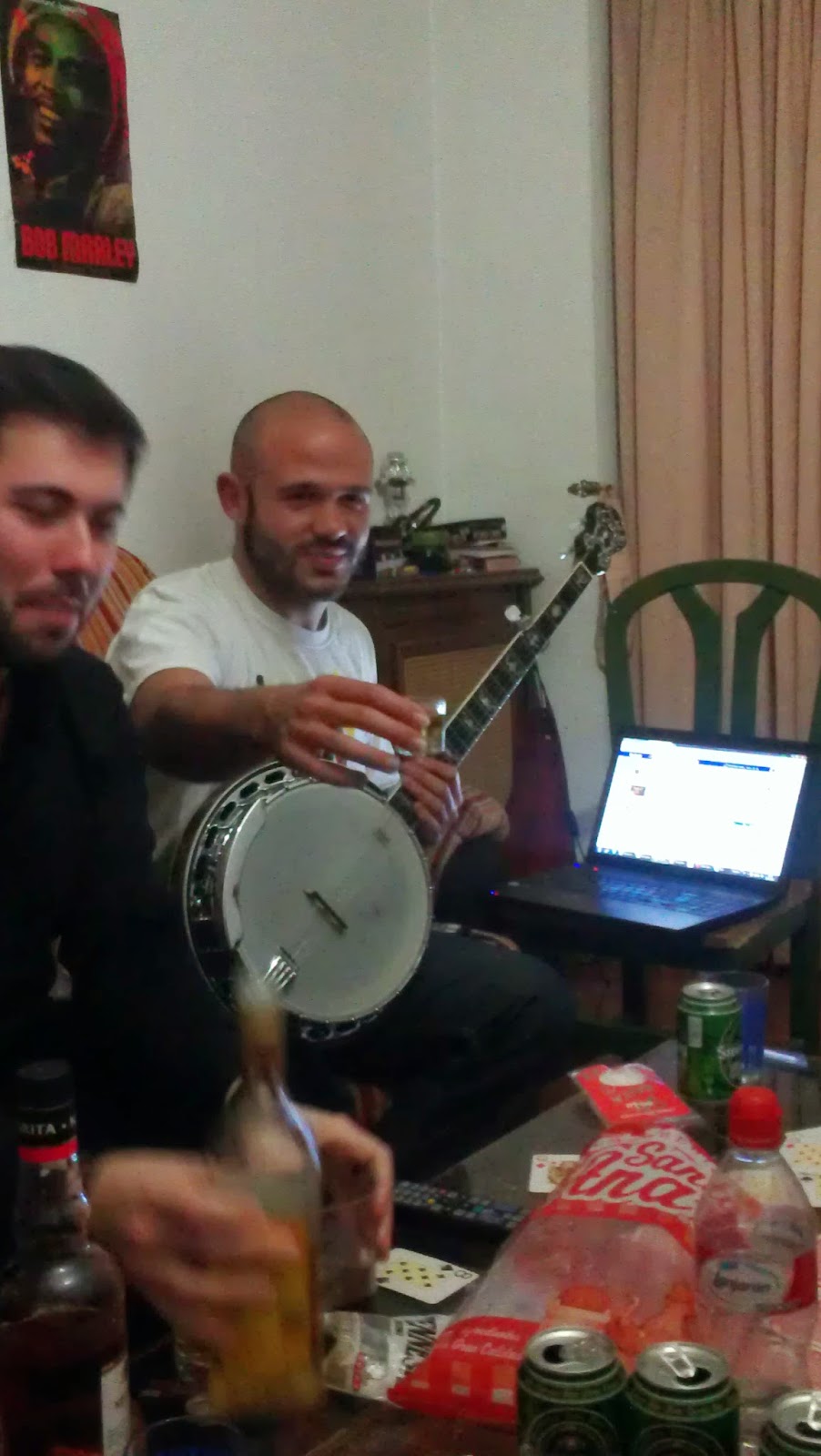.jpg) |
| Pre-gaming, botellon style. Try it at home! Banjo optional. |
My loose interpretation for botellon, is 'bring a bottle and some of those cups...'. Though they usually occur outside of the house in a plaza or park, I think it's far to call anything a botellon that involves more than 1 person bringing more than 1 bottle to share with the intent of drinking as much as possible before the night is over.
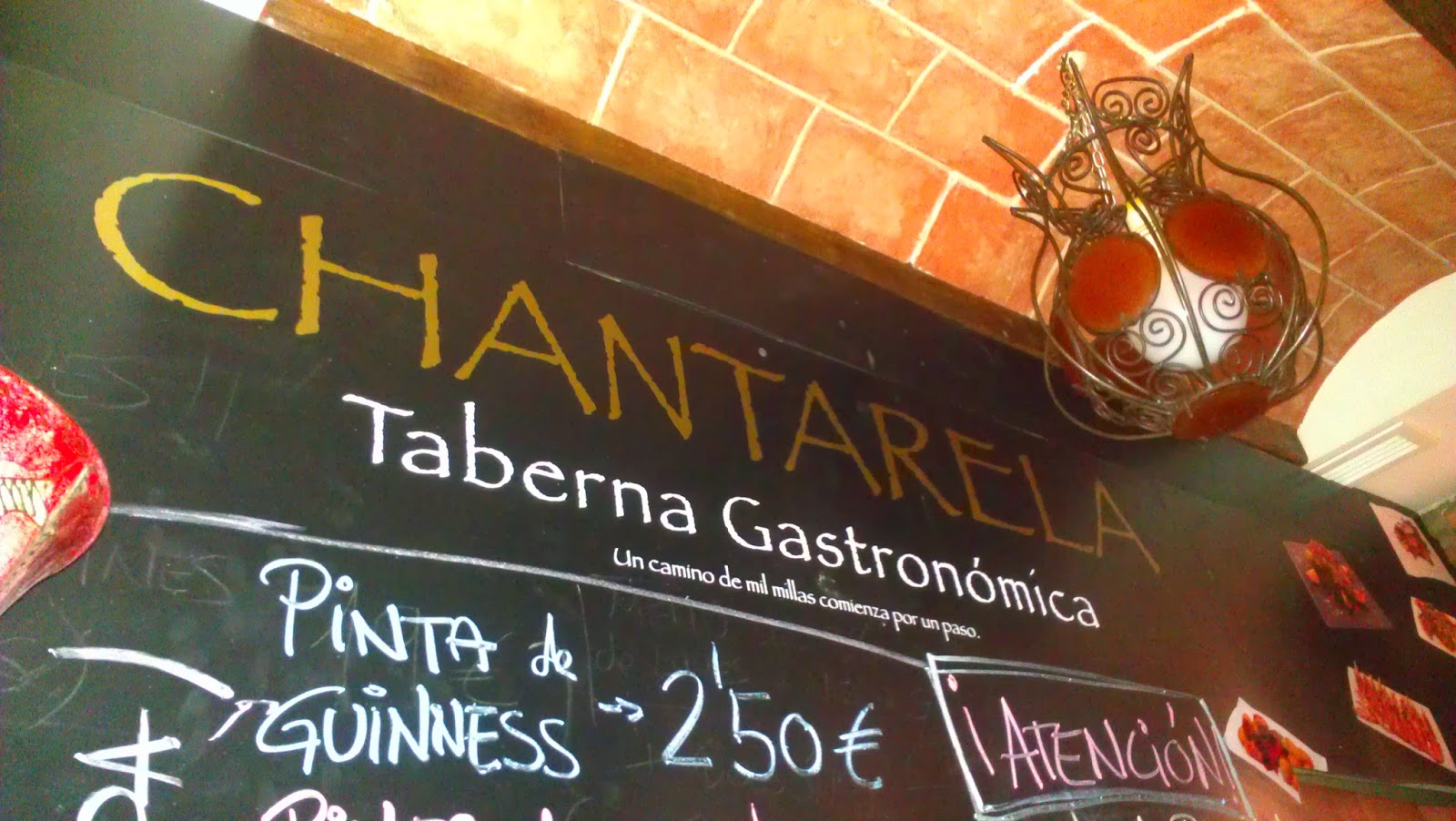.jpg) |
| First, to Chantarela for a few rounds of tapas and copas... what else? |
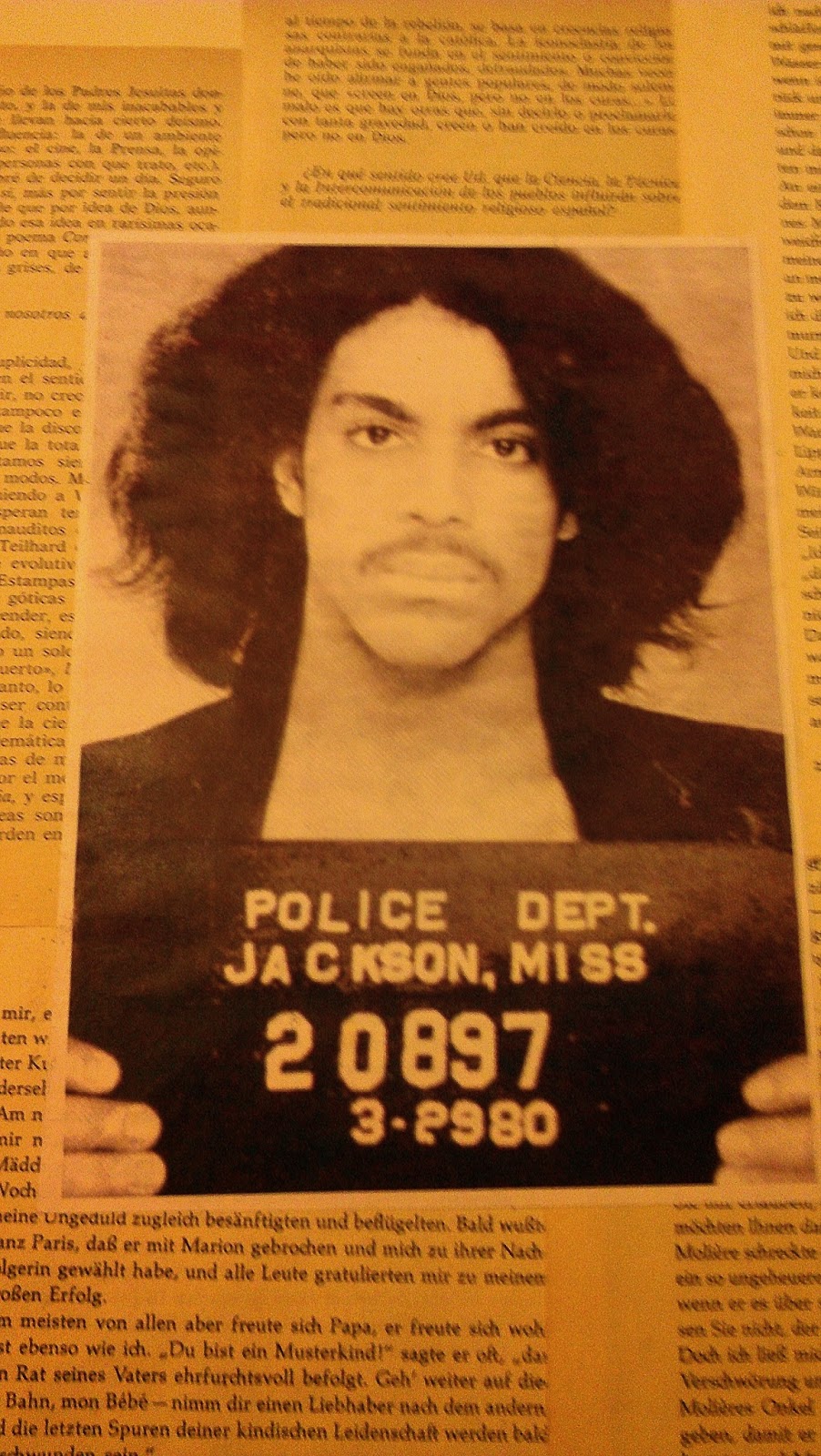.jpg) |
| Our next stop was a crowded, energetic bar where this guy ogled me in the bathroom. I didn't mind. |
After a several hours of making the rounds, we night creatures all headed back to our coffins. By the time I made it back to my room and collapsed, it was a little after 4am.
La Morena Comes to Visit
"Oh crap, what time is it?" was my first thought upon waking the next morning. I was supposed to be meeting up with Dominique (aka, La Morena de Andalucia), who I had pestered until she agreed to come into Granada so we could hang out for the day. We strolled around Granada catching up on everything until it was time for me to head off to my appointment at the nearby hammam.
 |
|
|
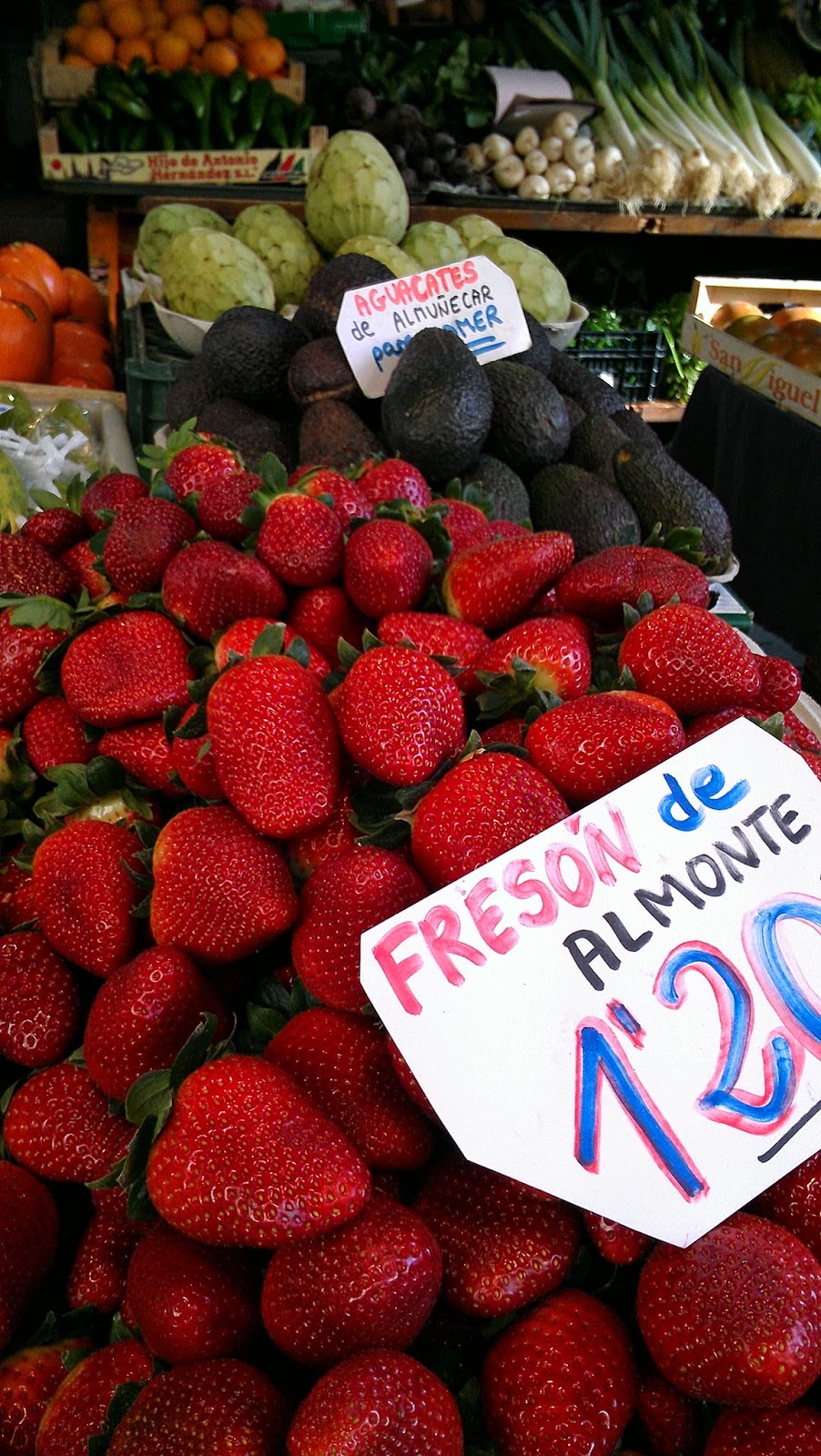.jpg) |
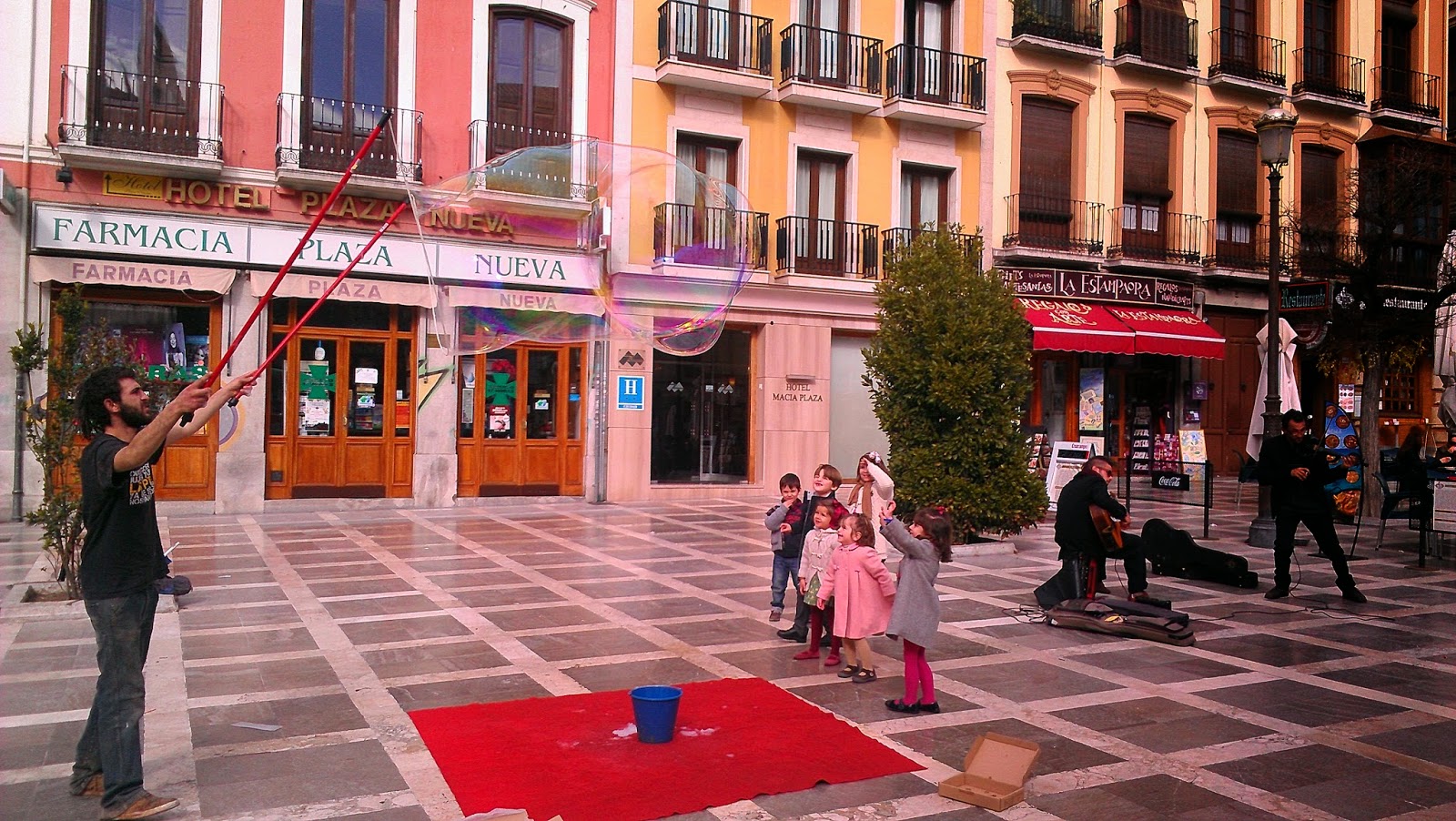.jpg) |
| kids playing at plaza nueva |
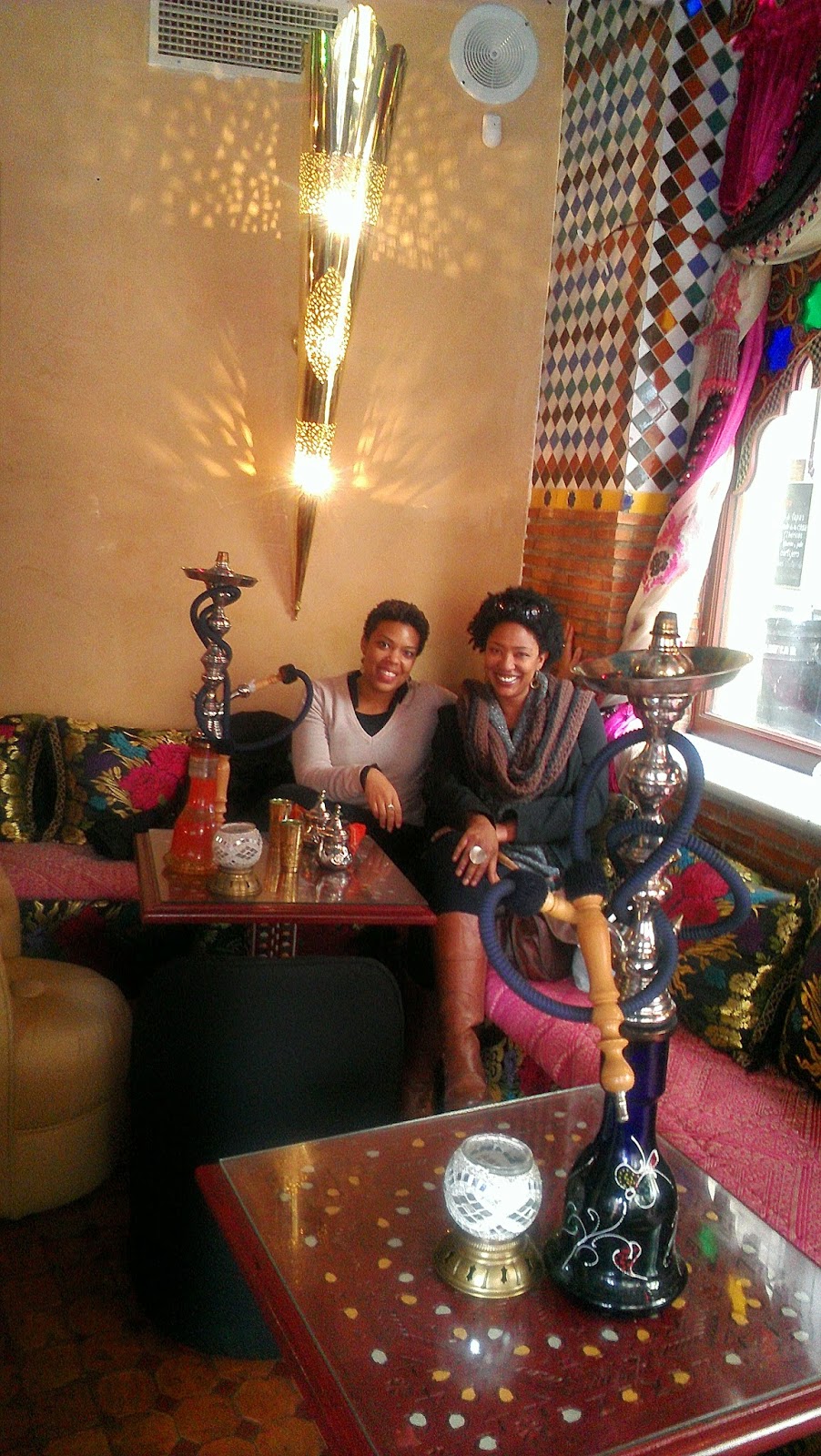.jpg) |
| 2 for tea - Dominque and me at a teteria on Elvira |
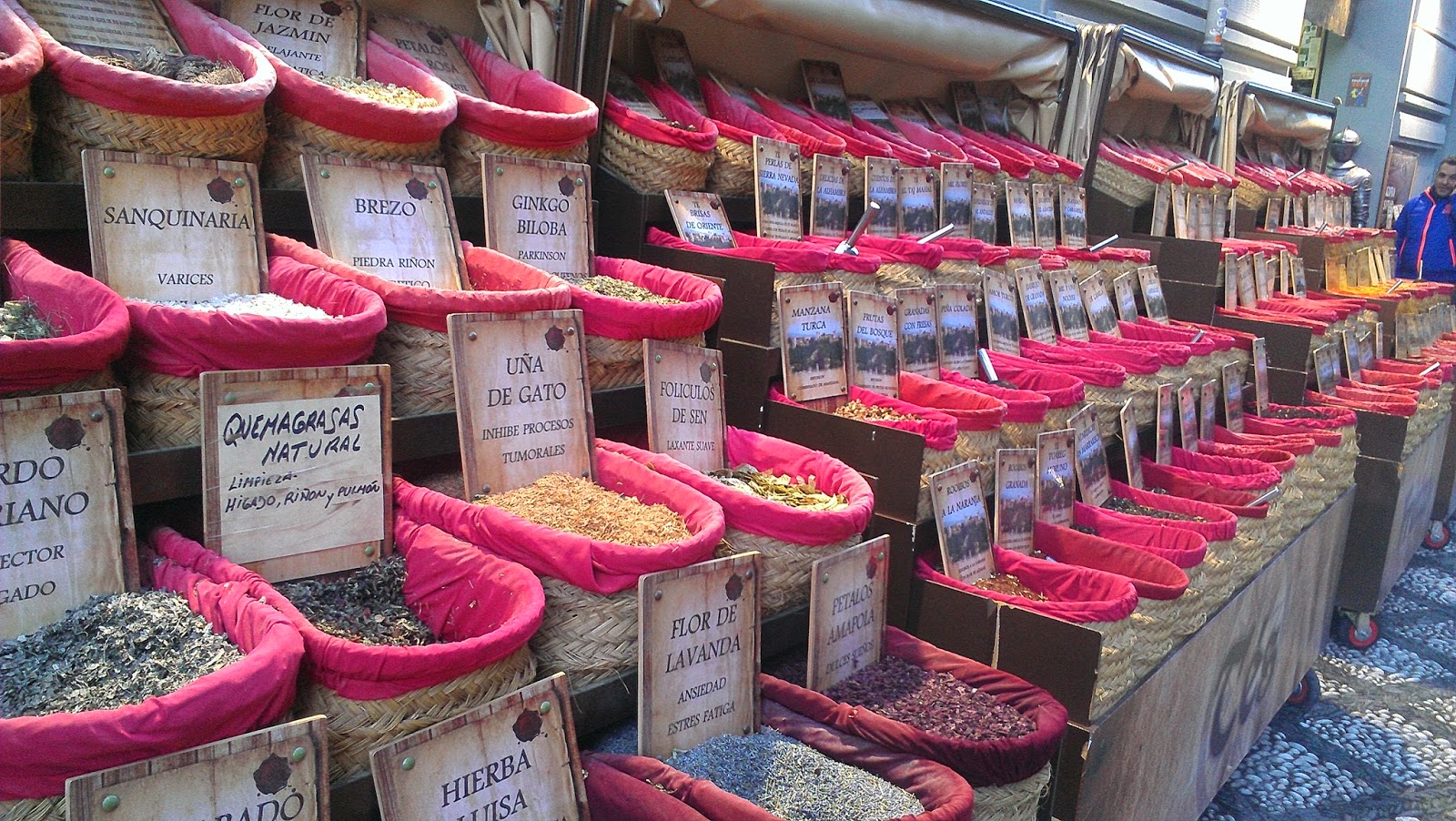.jpg) |
| spice vendor near granada cathedral |
Hammam Al Andalus
After all the walking at the Alhambra and the Albayzin the previous day, followed by a long night of 'botellon and bars', my poor body needed some rejuvenation. The Hamma al Andalus was right on time.
.jpg) |
| No pictures allowed inside. But I managed to sneak this one of me with my shoe shower caps. |
Inside the hammam are 3-4 'baths' or large soaking pools - each has a different temperature (from ice cold to warm-but-not-hot). There's also a steam room and a massage area. My entry fee of 25€ included admission to the baths for 2 hours and a 15-minute massage. The massage was pretty good, and I felt the price was fair, especially because I needed it so badly.
After the hammam, I met up with Dominique, Nicole, and Allison (aka, the out-of-towners) for tapas at Bella y la Bestia.
.jpg) |
| I'm giddy from an excess of carbs and a lack of sleep. |
Soon, it was time for Dominque to head back to Huelma. We hung out a bit more around Elvira, and then I saw her off to the bus station.
Shisha and Bars
Saturday night. Last night in Granada. So I start it off by meeting up with Brit for shisha and a nice cup of tea. We're both a little hungover from the night before, and before we leave the teteria, Brit throws in the towel and heads home for the night. Fare thee well o Hiawatha. Fare thee well, O mighty warrior.
I went on to meet up with the rest of the girls for a couple of bar stops:
First, at Chantarela (Yes, again. Cuz it was that good.)...
Then, at Poe, where Allison had her first taste of absinthe...
And finally, at one of these interesting Spanish drinking establishments I call 'shot houses' - a bar that's really popular because they serve a dizzying array of shots for about 1euro each.
All in all, it was a nice way to wrap up the weekend.
And it was a good thing I booked my return bus for the afternoon. I definitely needed to sleep in.







.jpg)
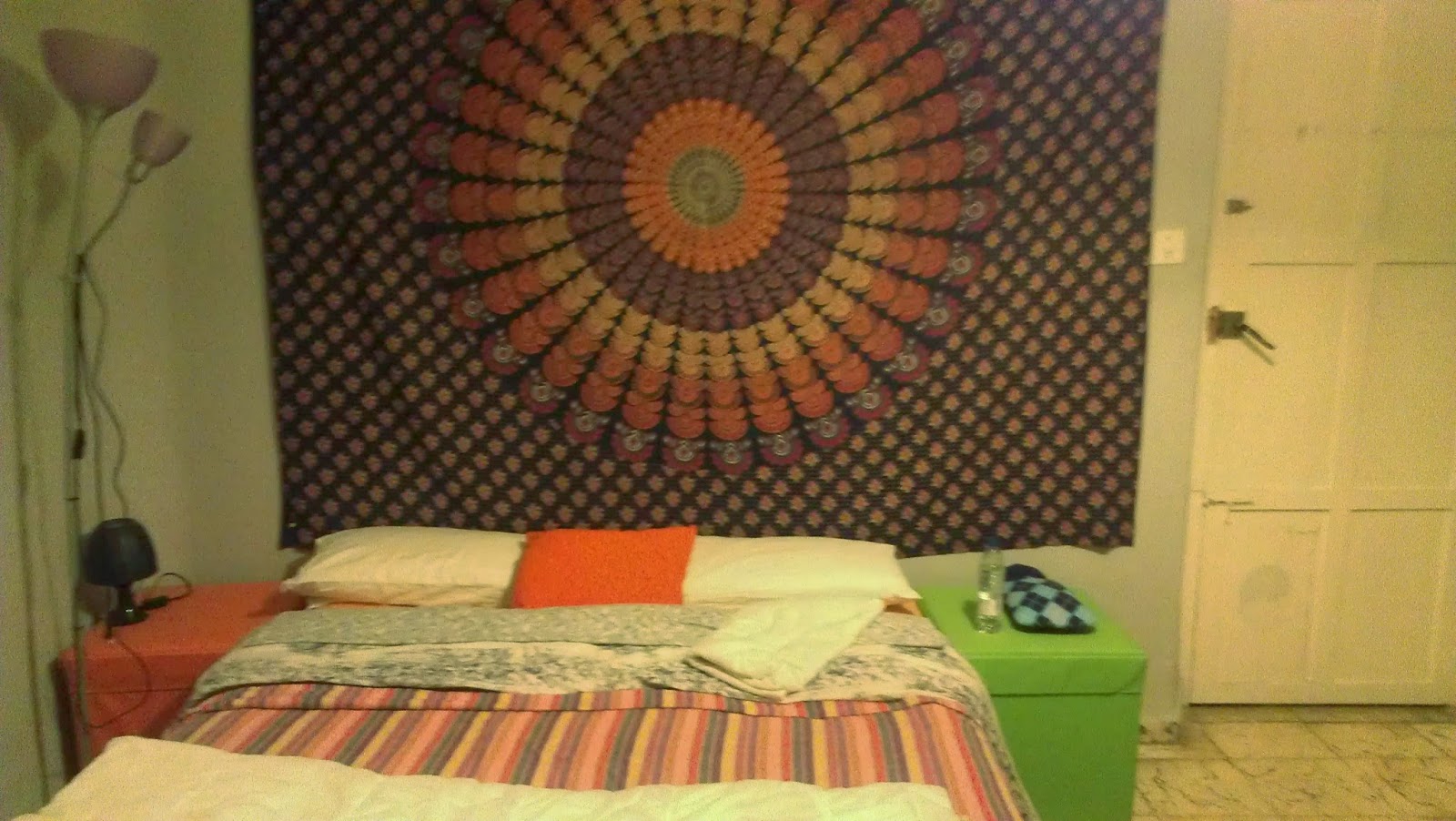.jpg)
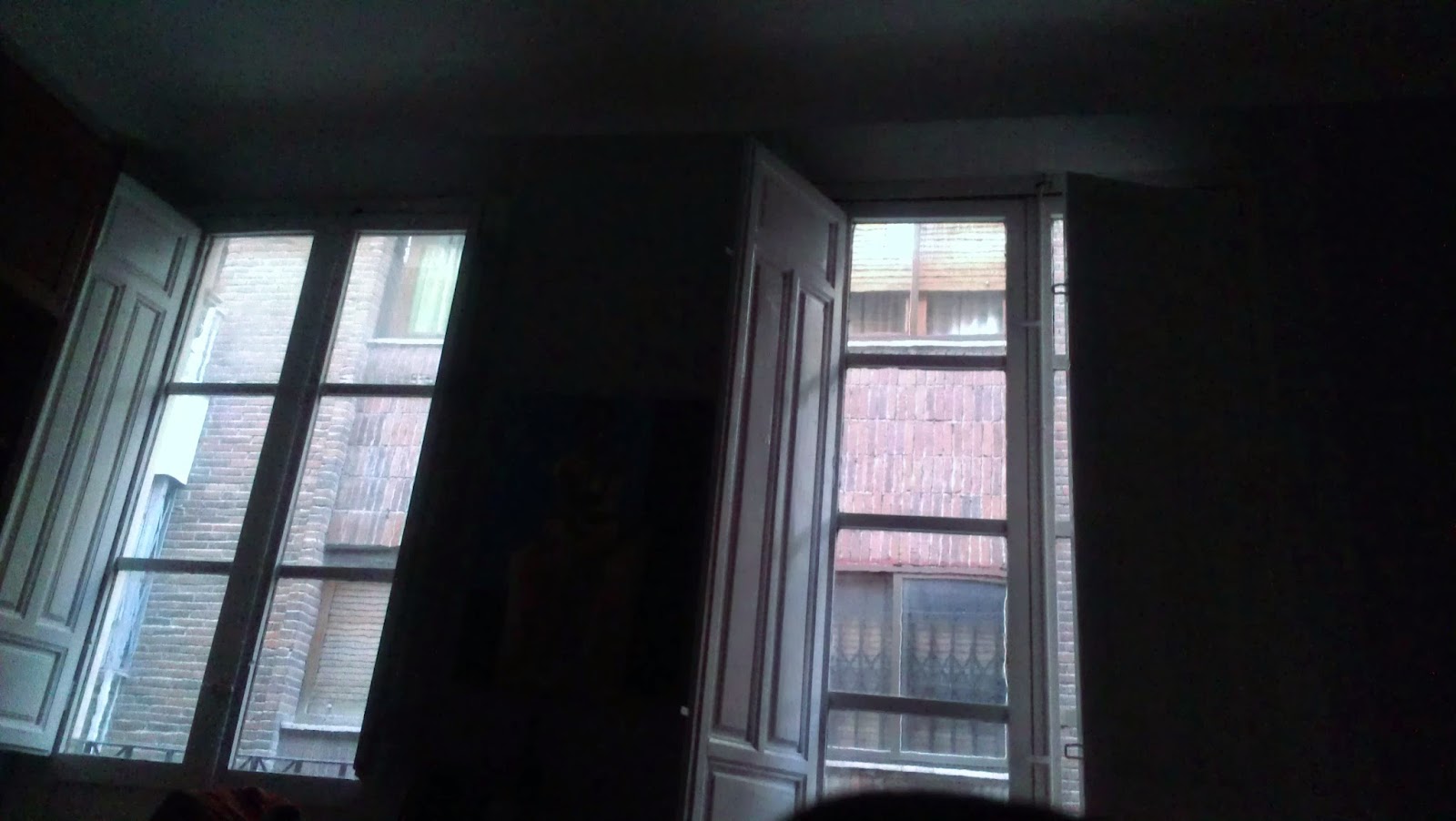.jpg)
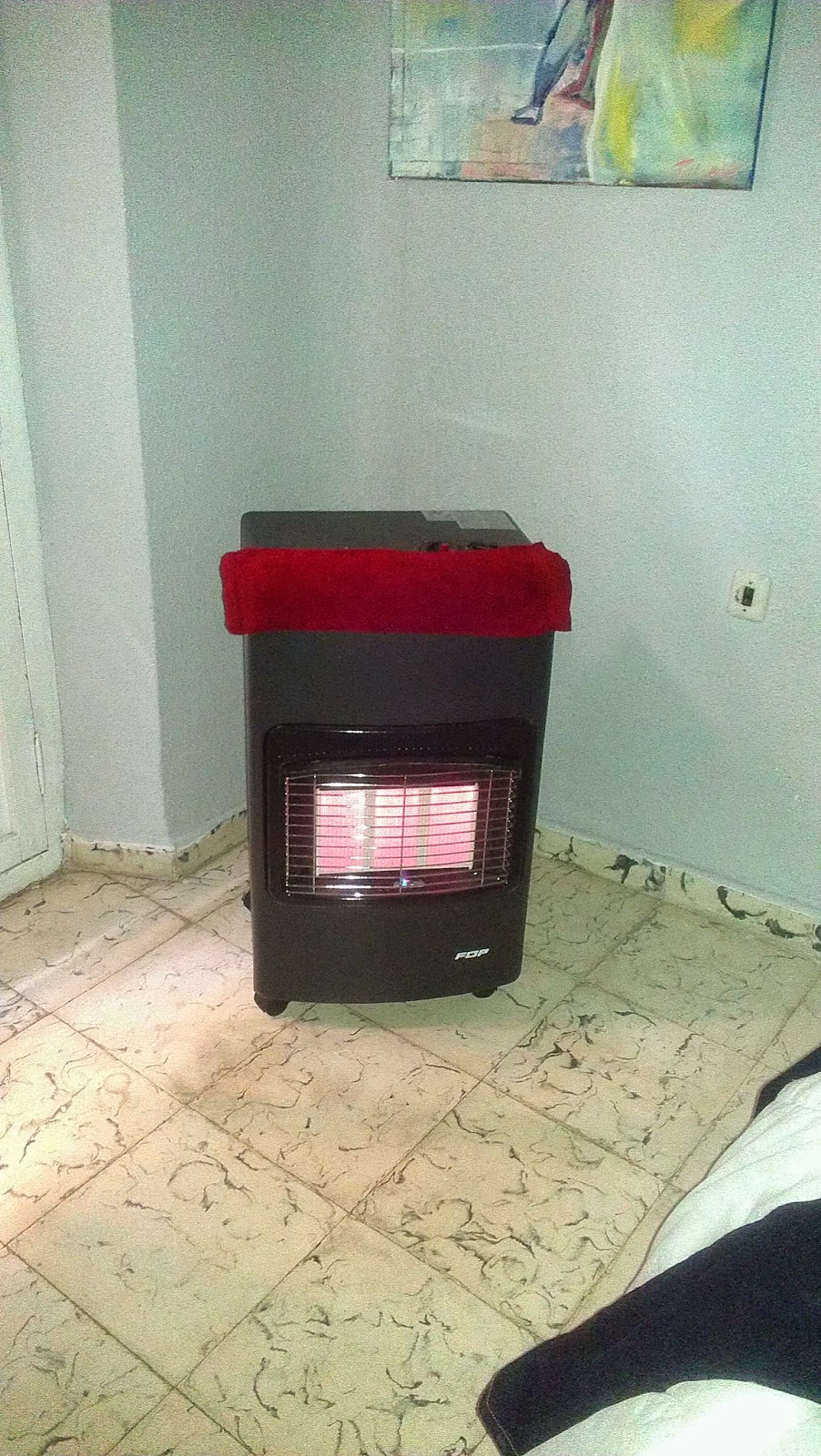.jpg)













































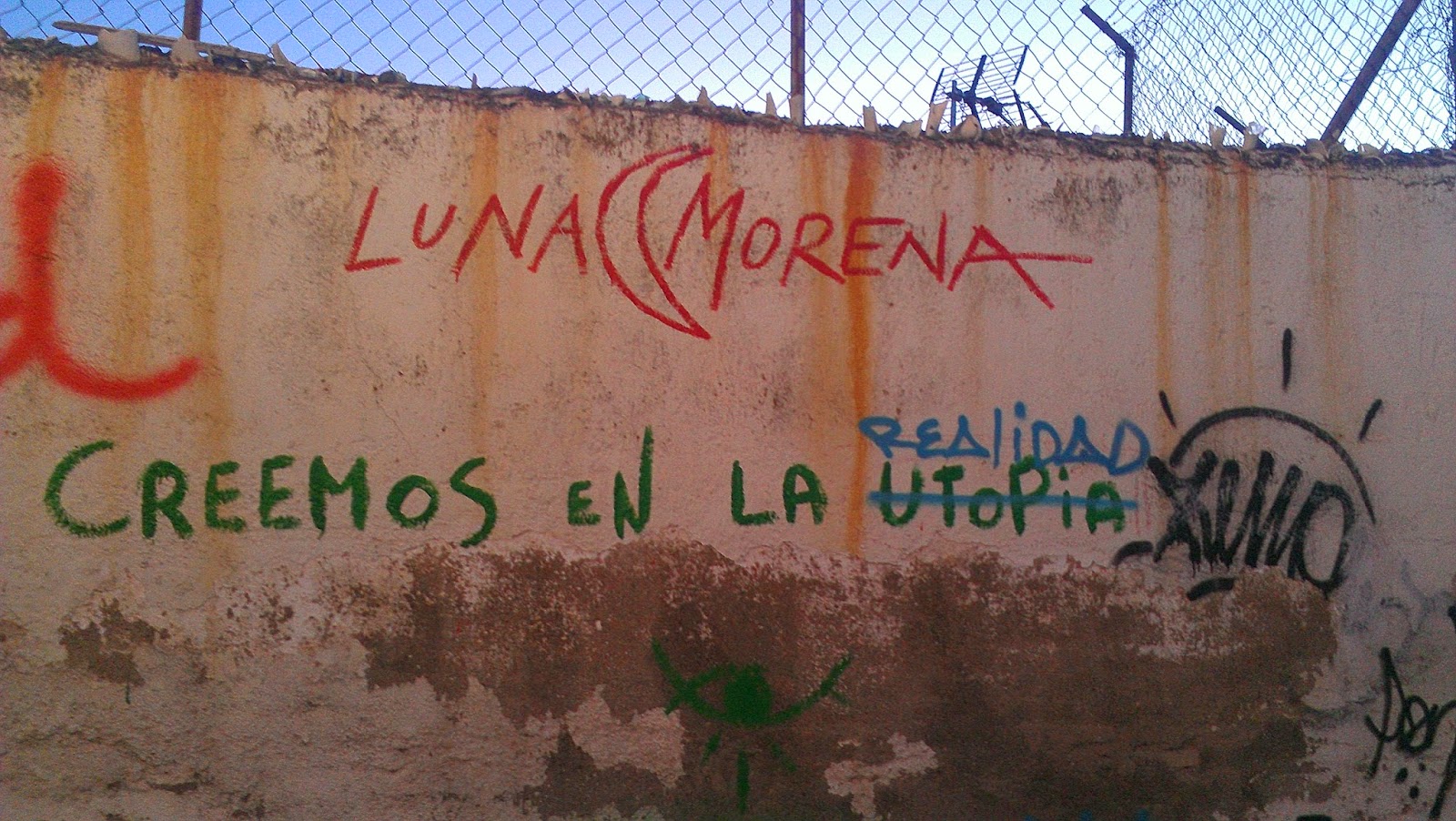


.jpg)

.jpg)

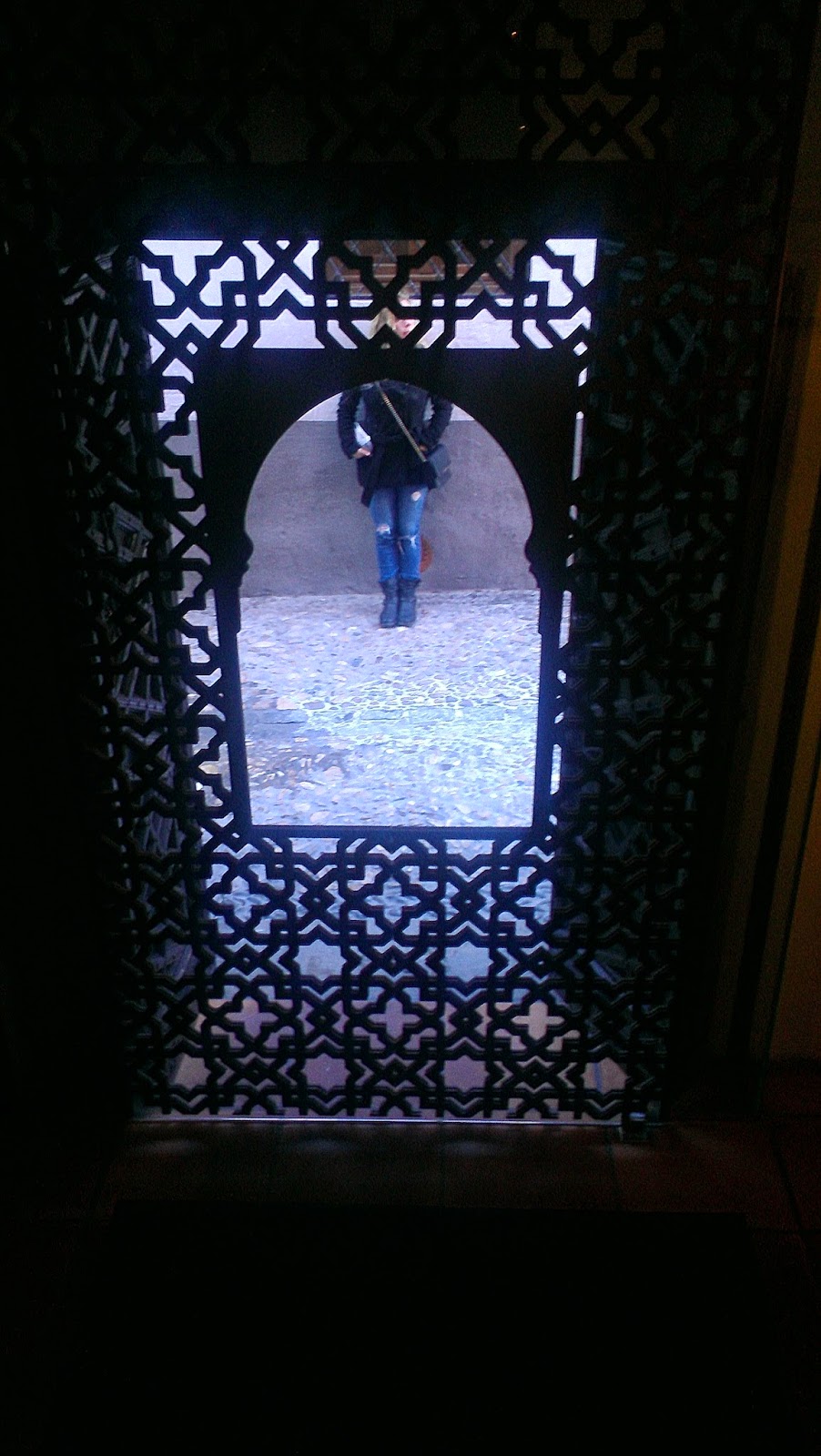.jpg)
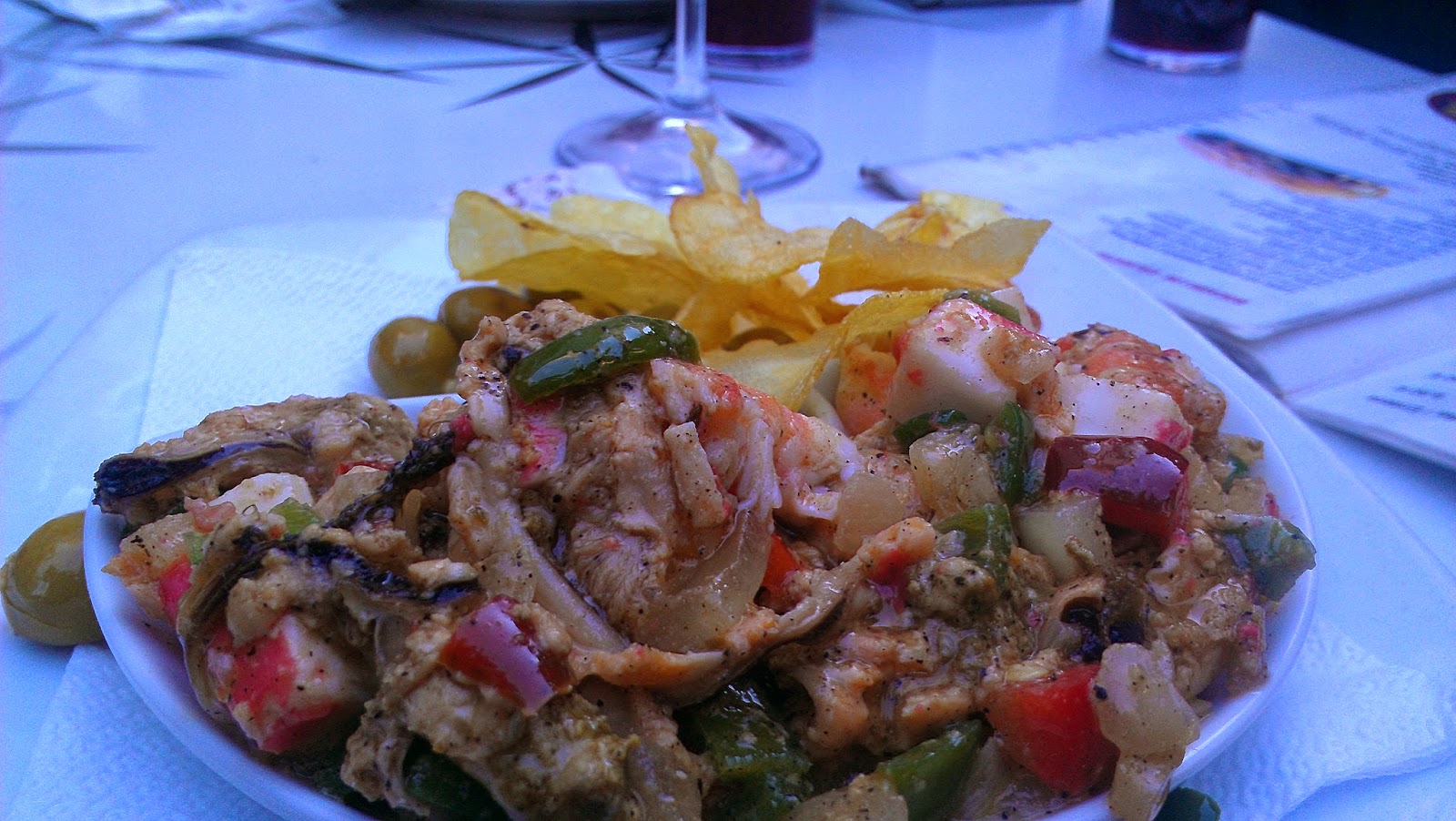.jpg)
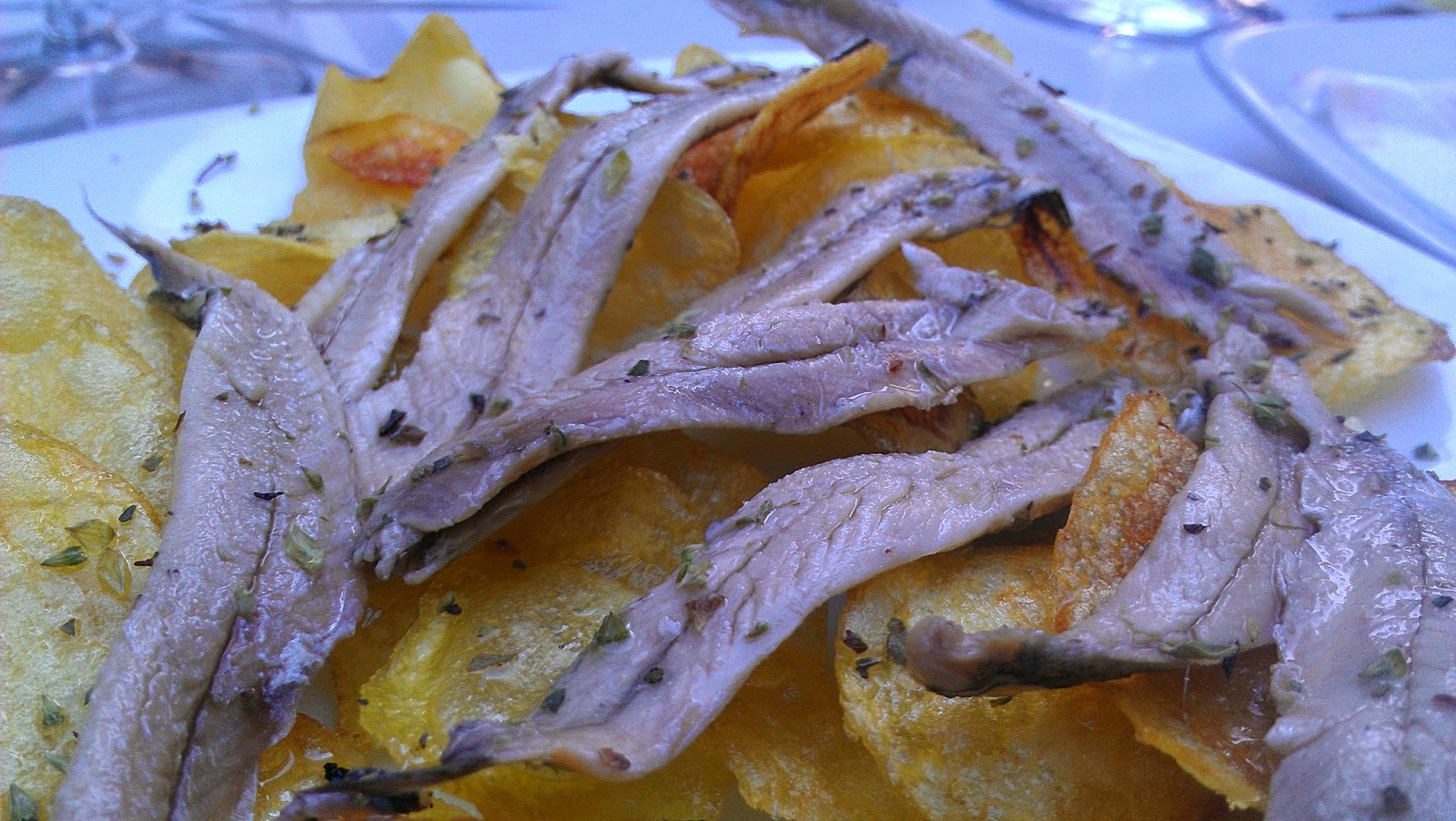.jpg)

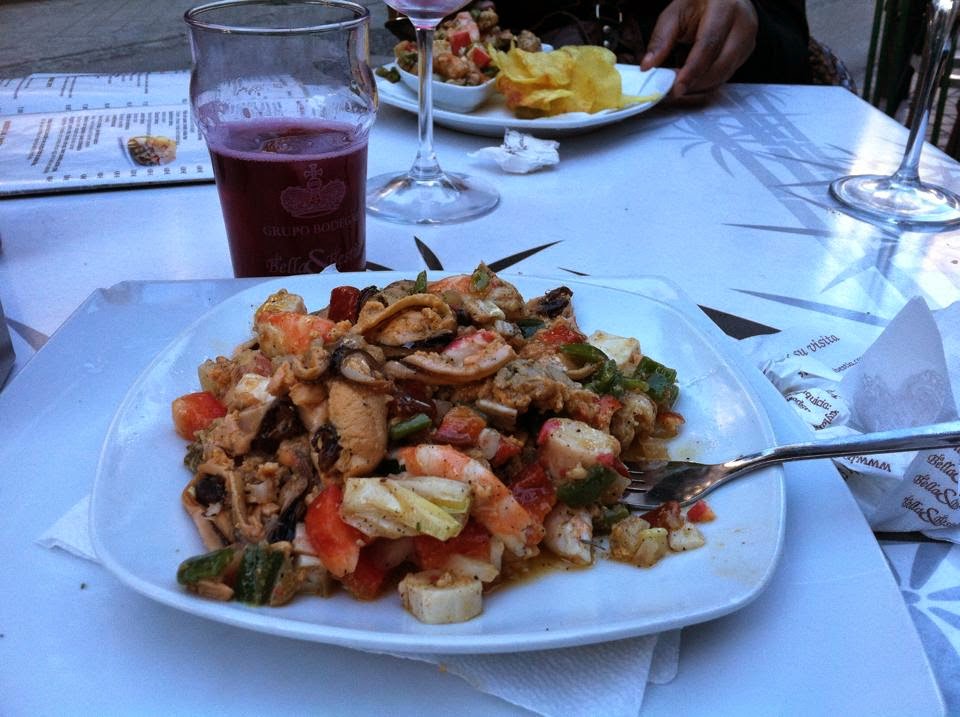.jpg)
.jpg)
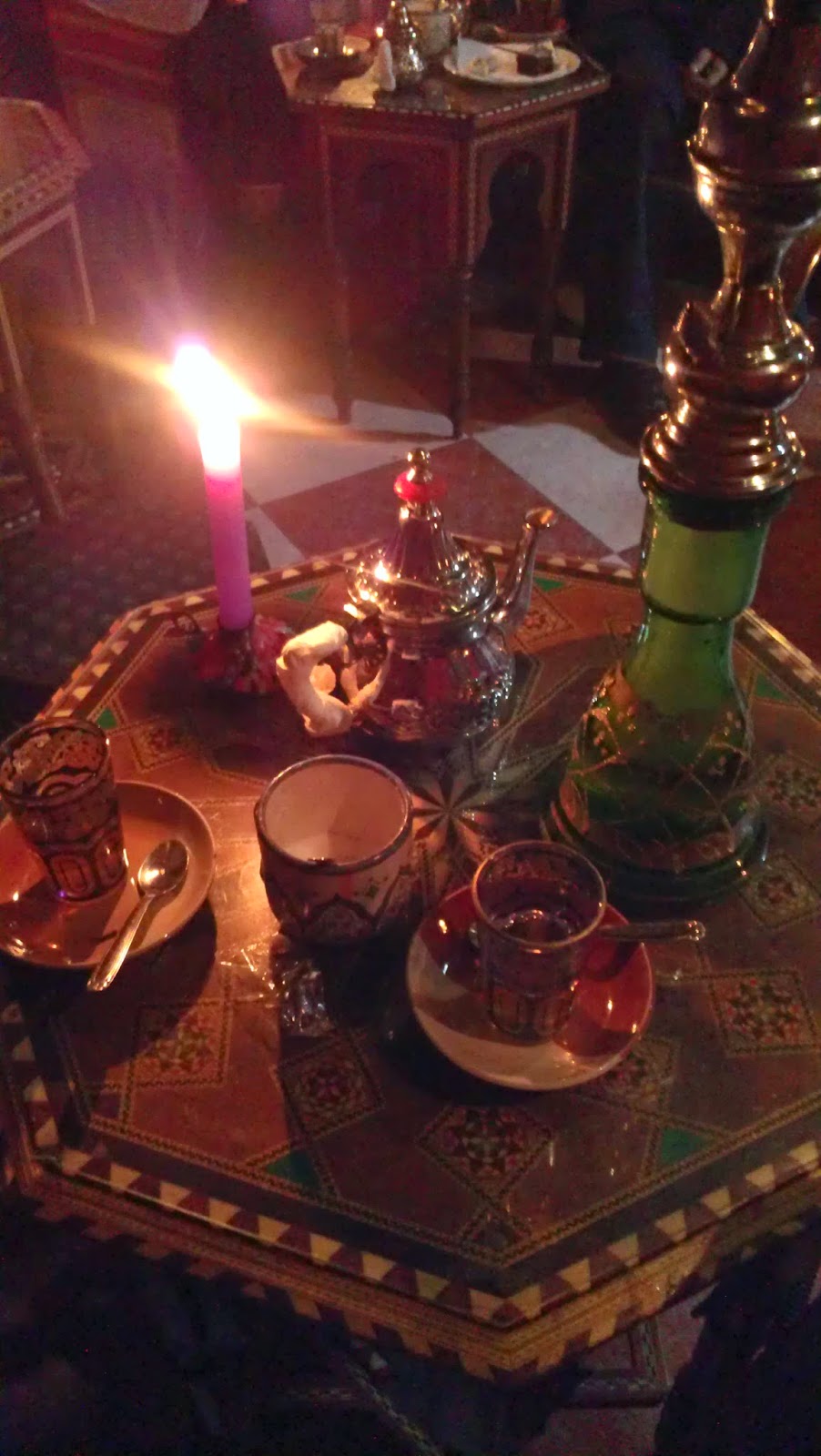.jpg)

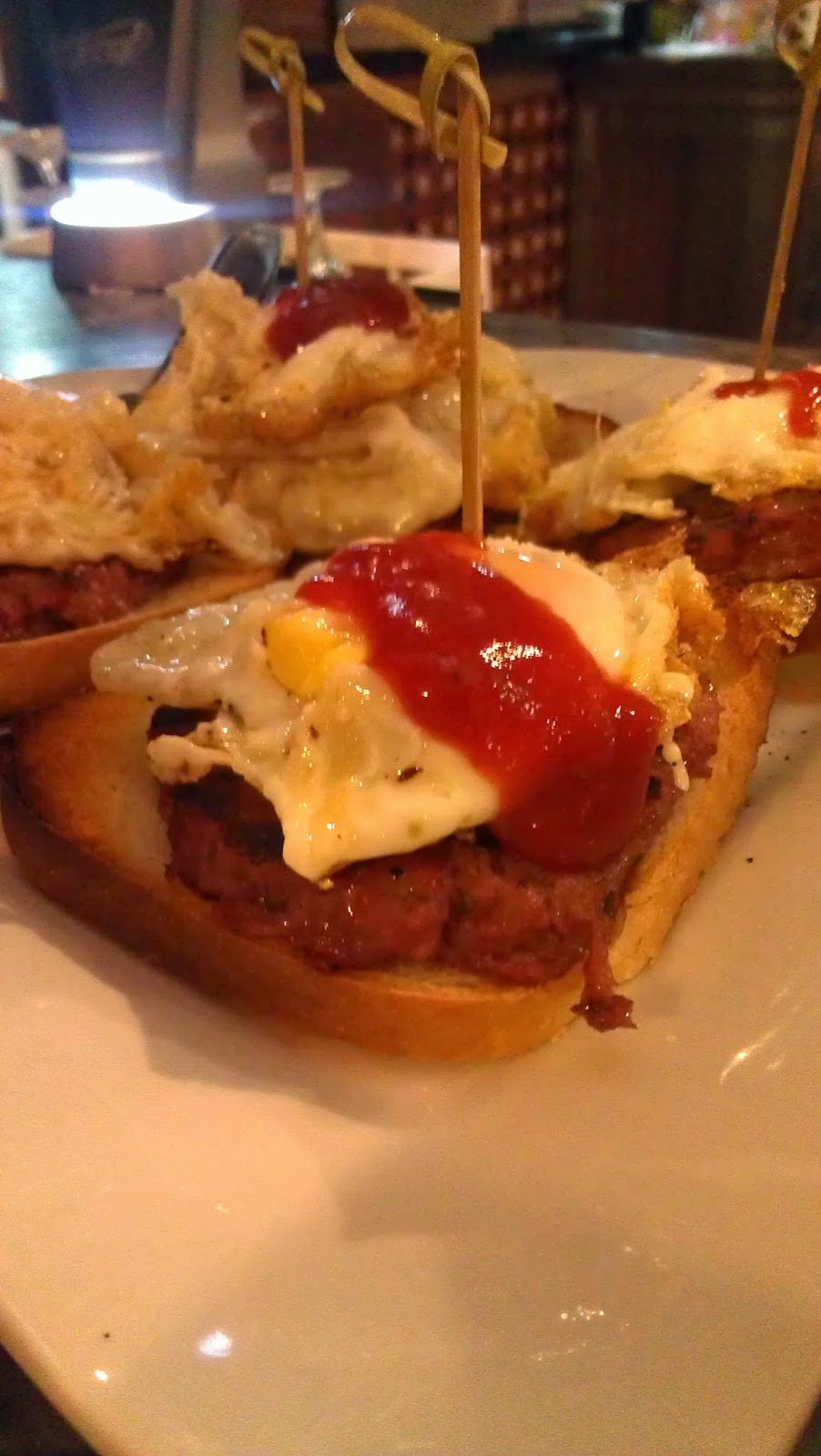.jpg)
.jpg)
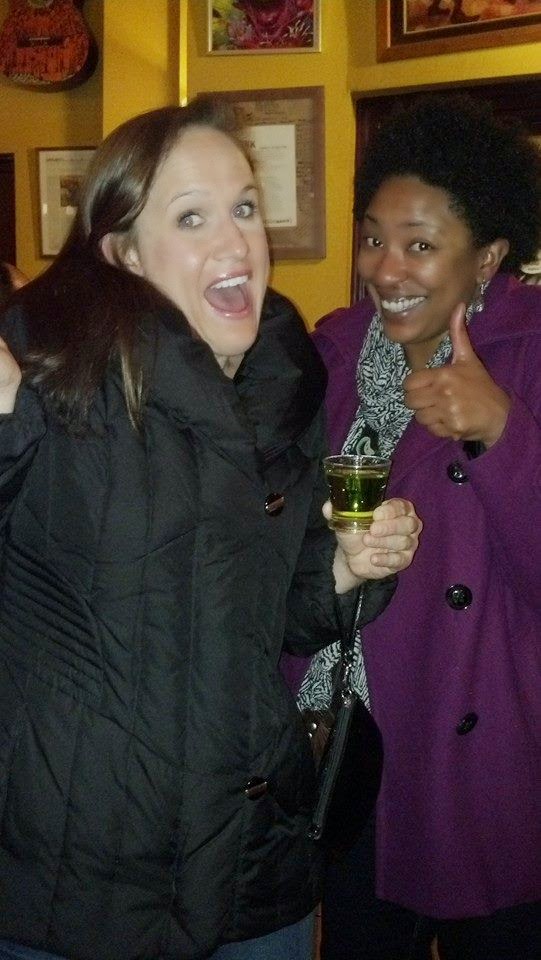.jpg)
.jpg)